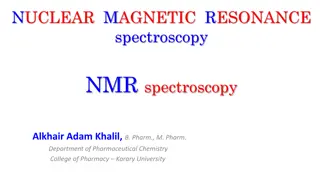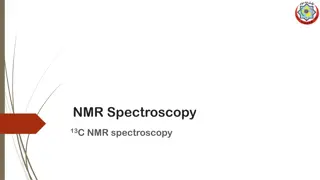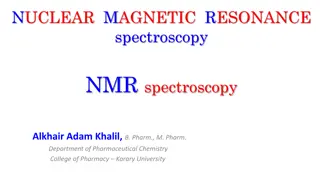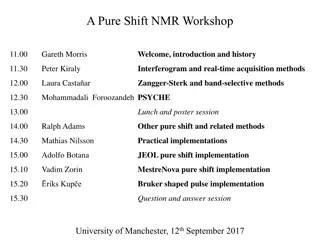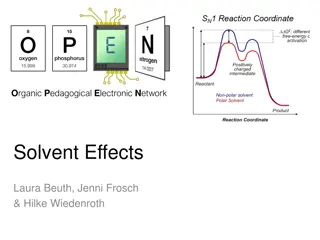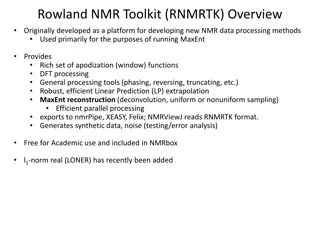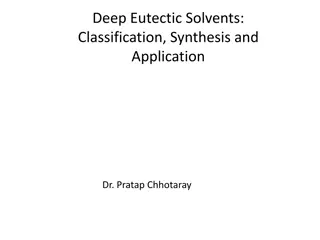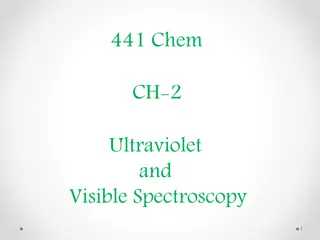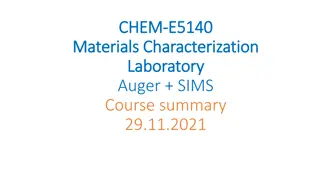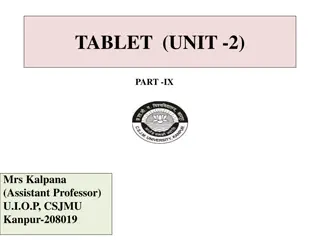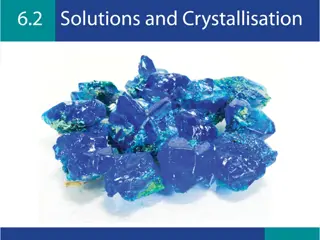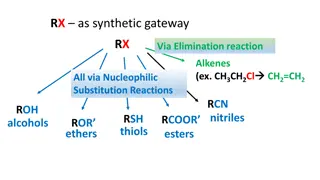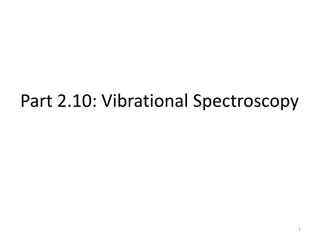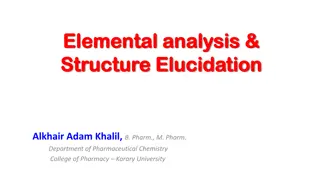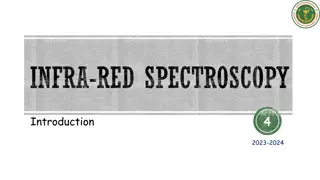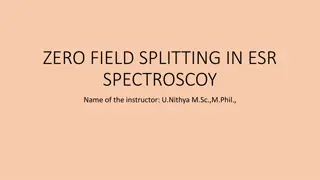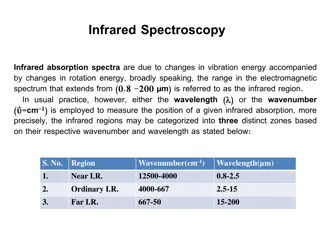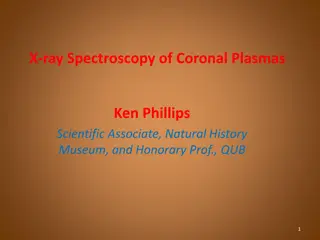Understanding Solvents in NMR Spectroscopy
Solvents play a crucial role in NMR spectroscopy, with characteristics like chemical inertness and lack of hydrogen atoms being key. Deuterated solvents are commonly used, but even they may show peaks due to impurities. Different deuterated solvents have varying chemical shifts and multiplicities for residual protons. However, some solvents like D6-DMSO and deutero methanol have challenges with water affinity. Integrating signals in the NMR spectrum helps quantify the number of protons in different chemical environments within a molecule.
Download Presentation

Please find below an Image/Link to download the presentation.
The content on the website is provided AS IS for your information and personal use only. It may not be sold, licensed, or shared on other websites without obtaining consent from the author. Download presentation by click this link. If you encounter any issues during the download, it is possible that the publisher has removed the file from their server.
E N D
Presentation Transcript
Lec5 5th stage Advanced Pharmaceutical Chemistry 2018-2019 Assist prof. Dr.Rita Sabah Elias College of Pharmacy, university of Basrah
Useful Solvents in NMR A substance free of proton should be used as solvent (i.e., which does not give absorption of its own in NMR spectrum). Some important characteristics of solvents for NMR spectroscopy are: 1. It should be chemically inert and magnetically isotropic. 2. It should be devoid of hydrogen atom. 3. It should dissolve the sample to a reasonable extent. The NMR spectrum of even completely deuterated solvent does show one or more peaks. It is due to the presence of minor impurities in the solvent (the deuteriated solvents are available commercially in 98-99.9%isotopic purity).
Chemical shift and multiplicities of residual protons in commercially available deuterated solvents. Solvent Approximate for 1H equivalent (as contaminant) 13C value Acetic acid d4 ( CD3COOD) Acetone-d6(CD3COCD3) Acetonitrile-d3(D3CCN) Benzene d6(C6D6) Carbon tetrachloride (CCl4) Chloroform d (CDCl3) Deuterium oxide d2(D2O) Dimethylsulphoxide-d6 (D3CS(=O)CD3) Methanol-d4 (CD3OD) Ethanol-d6 (D3CCD2OD) Pyridine-d5 (C5D5N) 13 and 2(5) 2(5) 2(5) 7.15 - 7.24 4.82 2.5(5) 21(7) , 177 30(7), 205 1.3(7), 117 128(3) 97 77(3) - 39.4(7) 3.4 (5), 4.8 49(7) 1.1(br), 3.55(br), 5.26 7.5 17.2(7), 56.8(5) 123.4(3), 135.4(3), 149.8(3) 66.5(5) Dioxane d8 (C4H8O2) 3.53(m)
Notes about some solvent 1. D6-DMSO has affinity for water, which makes it almost impossible to keep dry, even if it s stored over molecular sieves Which make D6-DMSO has a large water peak, which varies in shape and position, from sharp and small at around 3.46 ppm, to very large and broad at around 4.06 ppm in wetter samples. 2. Deutero Methanol (CD3OD), like DMSO it has a very high affinity for water and is almost impossible to keep dry. Its water peak is sharper and occurs more predictably at around 4.8 ppm. 3- Its main disadvantage of deutero methanol (CD3OD) is that it will exchange ionisable protons in your sample for deuterons, and hence they will be lost from the spectrum, e.g., -OH, -NH and even -CONH2; though these can often be relatively slow to exchange. 4- D2O, like deutero methanol, it exchanges all acidic protons readily and exhibits a strong HOD signal at about 4.9 ppm. Samples made up in D2O often fail to dissolve cleanly and benefit from filtration through a tight cotton wool filter.
Integral and integration The NMR spectrum not only distinguishes how many different types of protons a molecule has, but also reveals how many of each type are contained within the molecule. In the NMR spectrum, the area under each peak is proportional to the number of hydrogen s generating that peak. Signal intensity is proportional to the number of protons present in each of the chemical environment within the molecule. The NMR spectrometer has the capability to electronically integrate the area under each peak. It does this by tracing over each peak a vertically rising line, called the integral, which rises in height by an amount proportional to the area under the peak. Integration: - it is a process by which relative areas under spectral peaks are measured.
Note that the height of the integral line does not give the absolute number of hydrogens. It gives the relative number of each type of hydrogen. The first integral rises for 55.5 divisions on the chart paper; the second, 22.0 divisions; and the third, 32.5 divisions. These numbers are relative. One can find ratios of the types of protons by dividing each of the larger numbers by the smallest number:then we arrive at the true ratio by multiplying each figure by 2 and rounding off to 5:2:3
The peak at 7.3 ppm, which integrates for five protons, arises from the resonance of the aromatic ring protons, whereas that at 2.0 ppm, which integrates for three protons, is due to the methyl protons. The two-proton resonance at 5.1 ppm arises from the benzyl protons. Notice that the integrals give the simplest ratio, but not necessarily the true ratio, of numbers of protons of each type. The spectrum of benzyl acetate shown below was obtained on a modern FT-NMR instrument operating at 300 MHz. The spectrum is similar to that obtained at 60 MHz. Integral lines are shown as before, but in addition, you will observe that digitized integral values for the integrals are printed below the peaks. The areas under the curve are relative and not absolute. The integral values are proportional to the actual number of protons represented by the peak. You will need to massage the numbers shown in Figure to obtain the actual number of protons represented by a particular peak. You will find that it is much easier to do the math when digitized values are provided rather than by measuring the change in heights of the integral line. Notice that benzyl acetate has 10 total protons, so you need to massage the numbers to obtain 10 protons. Proceed as follows:
Factor influencing chemical shift Inductive effect ( Electronegativity effect):- The chemical shift simply increases as the electronegativity of the attached element increases. Following table illustrates this relationship for several compounds of the type CH3X
Note:- Silicon is more electropositive than carbon and pushes electron density towards the methyl protons. This increased shielding results in very low precessional frequency for such protons; indeed the protons in TMS have lower precessional frequency than protons in almost all other molecules, and its partly for this reason that TMS is used as reference slandered. - Multiple substituents have a stronger effect than a single substituent. - The influence of the substituent drops off rapidly with distance, an electronegative element having little effect on protons that are more than three carbons distant. Following table illustrates these effects for the underlined protons.
Following table illustrates these effects for the underlined protons. Electronegative substituents attached to a carbon atom, because of their electron-withdrawing effects, reduce the valence electron density around the protons attached to that carbon.
If an atom is placed in a uniform magnetic field, the electrons surrounding the nucleus are caused to circulate in a manner producing a secondary field which is opposed to the applied field in the region of nucleus. The circulation of electrons therefore causes shielding of the nucleus.
However, if the electron density around the atom is reduced due to inductive effect of a neighboring electronegative atom. The secondary field decreased, with result that resonance can now occur at a lower value of applied field. Hence electron withdrawal from a proton by an electronegative atom causes deshielding of the proton Electronegative substituents on carbon reduce the local diamagnetic shielding in the vicinity of the attached protons because they reduce the electron density around those protons. Substituents that have this type of effect are said to de shield the proton. The greater the electronegativity of the substituent, the more it deshields protons and hence the greater is the chemical shift of those protons.


